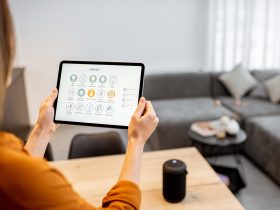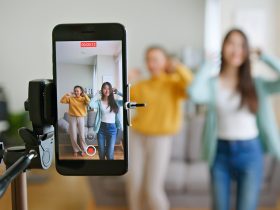How much social media, online shopping, and mindless scrolling make up your digital diet? And how many of us can say we lead balanced lives with no more screentime than we truly need to be productive and unwind? Now imagine a world with no notifications. No posts to be liked. Not another WhatsApp or email fluttering onto our screen. A digital detox can be a recipe for tranquillity in a chaotic virtual world that’s always “on” and greedily demanding our attention. For even greater peace of mind: Help keep your devices safe from digital threats with Avira Free Security.
The dark side of our digital world
Click here! Subscribe now! Read me! Do you feel overwhelmed by the barrage of notifications, emails, and social media lighting up your phone, tablet, and other devices? You’re not alone, and it’s understandable; anything relentless wears us down. In our contemporary, technology-driven society, everyday lives are increasingly governed by digital interactions—whether we’re ordering groceries from an online supermarket, endlessly scrolling at the slightest sign of boredom on the London Tube or attending more Zoom than in-person meetings since COVID-19 struck. Designed to be digital aids, internet-enabled devices now rule our world.
It’s not all bad. Few of us would choose to return to the days of paper-based ‘snail mail’, house-bound landlines or happily pound real pavements in search of the latest fashions. But constant connectivity and convenience carry a dark side, taking a toll on our mental and physical well-being, and potentially even leading to stress, sleep disturbances, and the inability to ‘switch off’ without being distracted by a ping or vibration. According to the independent non-profit, HelpGuide, which is dedicated to helping us improve our mental health, excessive use of social media can fuel feelings of addiction, anxiety, depression, isolation and FOMO (fear of missing out). Human beings are social creatures, and we need the companionship of others to thrive. That means real-world interaction and not montages of other people’s picture-perfect moments masquerading as real life. Social media is also a playground for cyberbullying, online harassment, and online grooming of vulnerable young people who don’t know how to protect themselves.
So, how can we break free from a digital trap that we’ve set ourselves, even if only for a short time? A digital detox could be the answer and a long-overdue opportunity to step back, refresh, and reconnect with the real world. Spending less time online also means you’ll reduce your digital footprint and be less likely to overshare your personal details where they can be scooped up by hackers or anyone trying to track you.
The concept of a digital detox has gained momentum in recent years. It involves taking a deliberate break from mobile devices such as smartphones, laptops, tablets, and even social media platforms for a specific length of time (determined, of course, by the detoxers themselves. You’re in control!). The more your fingers start twitching for Twitter, Snapchat, YouTube, TikTok, and co, the more overdue your digital break is likely to be.
Now … imagine waking up to a world free from “read me now!” emails and the crushing insecurity that everyone looks better than you (thank you, Insta filters). You might even have time for a real walk with another human being. This is the essence of a digital detox—living in the (real) moment, feeling the grass between your toes and rediscovering a big world beyond that little screen. And the best part? It’s entirely within reach.
The benefits: It’s time to replace digital overload with a digital detox
There’s another downside to our constant digital connection and it extends beyond personal well-being to affect our relationships, productivity, and even ability to think critically. The instant gratification provided by digital devices triggers a dopamine release and can lead to addictive behaviour. The need for constant stimulation overrides our ability to focus and engage deeply with tasks.
This may result in a fragmented attention span, making it more difficult to complete projects or even engage in meaningful conversations and even basic interactions with those around us! To see how widespread this issue is, just look around during your next visit to a restaurant and notice couples and even entire families glued to their screens, hardly interacting with each other!
The all-pervasive nature of digital technology can also create a sense of disconnection as virtual interactions replace face-to-face connections, leading to feelings of loneliness and isolation. Just as we prioritise other forms of self-care, like eating healthily, taking a break from work or finding the time to go to the gym, it’s crucial that we learn to recognise the potential harms of our digital world. Acknowledging the problem is a first step—then commit to a digital detox.
And if you’re yelling “I don’t need a digital detox”, or “I don’t want to miss out”, you’re long overdue for a digital diet! This may seem daunting, but the benefits to our overall wellbeing often outweigh the initial discomfort. Here’s how your quality of life could flourish:
- Improve mental health: Reducing screen time can help alleviate symptoms of anxiety and depression. Without the constant barrage of notifications, you’re able to experience a sense of calm and mindfulness. A social media detox can also help to enhance self-esteem and reduce the pressure to conform to unrealistic standards that we see on our feeds. You’re finally free to appreciate yourself and your life without comparison.
- Get more glorious sleep: Limiting exposure to screens, especially before bedtime, has been linked to improved sleep quality. That’s because the blue light emitted by screens interferes with the production of melatonin (a hormone that regulates sleep), and this may be the reason you struggle to sleep and wake up just to doom scroll some more. The general rule of thumb is to reduce screen time by at least an hour before your bedtime. Read up on what the Sleep Foundation has to say on why electronic devices keep you up.
- Build stronger bonds: Keen to build stronger relationships with your nearest and dearest? Ditch your mobile phone every so often and create lasting memories by meeting up in person. Enjoy the ‘real’ world instead of framing it through the lens of your next Instagram post. You’ll also help keep those feelings of loneliness at bay.
- Elevate performance: Without the distraction of constant notifications, you can focus better on tasks, allowing you to check off that to-do list faster—and this in turn helps free up more time for relaxation and leisure.
- Be more creative: A break from digital distractions could even spur creativity! Engaging in offline activities like reading, writing, or drawing can stimulate your brain so you rediscover your creative side. Without the constant influx of information, your mind has the space to wander, imagine, and innovate. Think of an artist with a blank canvas.
- Boost health and wellbeing: Ever been swimming, running or mountain climbing while staring at a screen? Probably not, because we enter the digi-verse hunched over a screen, and our lives become more sedentary. Not getting enough exercise has been linked to various health issues, such as heart disease and obesity. And staring down at a screen can leave you with chronic neck and back problems. Instead of leaping from one series to the next, go for a walk or grab that pair of dumbbells. Stop your thumbs doing the tango on a keyboard and opt for a real dance class or yoga session. Health is wealth, as they say!
It might also be useful to remember that reducing your screen time helps keep you away from the prying eyes of those trying to track you online. From marketers to advertisers, every move you make is relentlessly monitored. You’re also less likely to be manipulated by fake news and can finally feel like the master and commander of your daily life and opinions.
Convinced? Here’s how to start your digital detox
There’s often a misconception that going on a digital detox means cutting out technology completely and living like a fifteenth-century hermit. No, you don’t have to head to a cabin in the woods (and movies that start that way rarely end well), nor search Google Maps for the nearest cave. And whatever you do, don’t smash your smartphone. It’s not about extreme measures but finding a healthier balance between on- and off-screen time and making intentional choices about when and how you use digital devices. Here are some tips and tricks to help you along:
1. Set clear goals
Determine what you want to achieve with your digital detox. Whether it’s reducing screen time, improving sleep, or spending more quality time with loved ones, having clear goals can keep you motivated. Write down your objectives and refer to them regularly to stay on track.
2. Communicate your plans
Let friends and family know about your digital detox to encourage them to support your efforts. It can make the process more fun, and you’ll feel compelled to be more disciplined if there’s an audience. Better still, reach out to a trusted friend and ask them to be your accountability partner or even join you with their own digi-diet!
3. Start small
Begin with short breaks and gradually extend them as you become more comfortable with disconnecting. This can help make the journey less intimidating and may increase your chances of success. You wouldn’t run a marathon without plenty of shorter runs beforehand, would you?
4. Create tech-free zones
Designate certain areas in your home that are device-free—like creating “no-go zones” for your gadgets. This could be your dining room (because Instagramming your food can wait). And if you really want the entire household to commit, consider imposing a small penalty for every violation—maybe whoever forgets gets washing-up duty!
5. Schedule screen-free time
Establish clear boundaries for when your device must definitely be off, for example during meals or within an hour of bedtime. This helps you create a structured approach to your digital detox while still letting you get things done online. It also means that you’ll have dedicated periods for relaxation and rejuvenation. Now might be the time to use that ‘Do Not Disturb’ feature on your phone.
6. Consider using digital detox apps
Isn’t using a digital app for a digital detox counter-productive? This is a ‘lesser of two evils’ scenario. There are digital detox apps that promise to help with a range of special measures and tools to provide insight into and control of your digital shenanigans (your overall screen time over the course of a week, for example). You’ll also be able to more easily track any progress (or lack of). Some lock your screen to cut you off cold turkey and others set you challenges and give you rewards to keep you motivated.
Timing your escape: How long should a digital detox last?
The duration of a digital detox can vary depending on your goals and personal preferences. Some people may choose to take a short break, such as a weekend or a week, while others bravely opt for a longer period, like (gasp!) a month. The key is to find a duration that is realistic for you and aligns with your objectives.
Don’t sneer at a short digital detox as even this can provide a quick reset, helping you gain a valuable new perspective on your digital habits. On the other hand, a longer detox can lead to more profound changes. Consider starting with baby steps in a manageable timeframe, such as a couple of hours (like when you get home from work until the morning).
As you become more comfortable with disconnecting, consider gradually extending the duration of your detox. Whether it’s a few days, weeks, or even a month, the goal is to create a sustainable and balanced approach to technology use. It’s your prerogative, so do what is achievable and fits into your daily world. Ignoring work emails and not answering the phone when your child’s school calls aren’t options for most of us, for example!
On your digital detox journey? Tips to help you stick with it and make it more fun
It’s easy to fall off the wagon, but if you do, simply get right back on. Also consider what may have caused you to head back into the comforting, ever-beckoning arms of social media and co. Did you find enough alternatives, for example? Identify activities that can replace the hours that you spent scrolling. How about reading a book, discovering a new hobby, or spending time with loved ones? Just make sure they look up from their own screens! Finding enjoyable alternatives can help you stay engaged and may reduce the temptation to revert to bad old habits.
Give yourself time to adjust to new habits and make adjustments as needed to stay on track. Regular practice reinforces your commitment to detoxification and helps lead to lasting change. Adjust your phone to limit certain social media apps if they keep tempting you.
Reflect on your progress and any benefits you’re experiencing. This can provide motivation to continue with your digital detox journey. Celebrate small wins and reward yourself (but not with more screen time). Why not invite your friends over for a day packed with offline fun like people did for thousands of years before mobile technology? You don’t have to go mammoth hunting. How about a morning hike or a hot yoga session? And if you want to channel your inner celebrity chef, opt for a cooking challenge where everyone brings a dish they’ve prepared, or cook a meal together. Set up an outdoor space for painting, DIY crafts … let your imagination run wild.
Lights out! A final word on digital detoxing and making long-term changes
If you’ve made it this far, it sounds like you’re getting serious about a detox. Great stuff!
It’s helpful to remember that a digital detox isn’t merely a buzzword. It serves as a valuable retreat where you can redirect your energy and reconnect with yourself. It offers a chance to tune out distractions and prioritize your wellbeing, empowering you to regain control over your digital habits. Ultimately, it’s a powerful and often very necessary act of self-care. Finding a balance in our media use is key to sustaining long-term changes.
At the end of your detox, don’t let your devices ensnare you again! Decide if you want to make long-term adjustments to your habits. Some changes you may want to implement are: Logging off at a certain time every night and leaving your phone in another room when you’re eating, resting, or socializing. Why not have a screen-free day every week? It might be easier than you think.
A detox (and tonic) for your devices: Choose trusted protection from Avira
Less time online means less exposure to online threats, but you can’t eliminate them completely. From phishing scams to malicious ads and downloads, it’s a digital minefield out there. A single misplaced click can expose you to a range of malware and even identity theft as hackers try to gain access to your data and digital life. A multi-pronged approach to online safety is crucial. That’s why Avira Free Security combines privacy, protection, and performance tools into a single, convenient solution for greater online safety and freedom.














